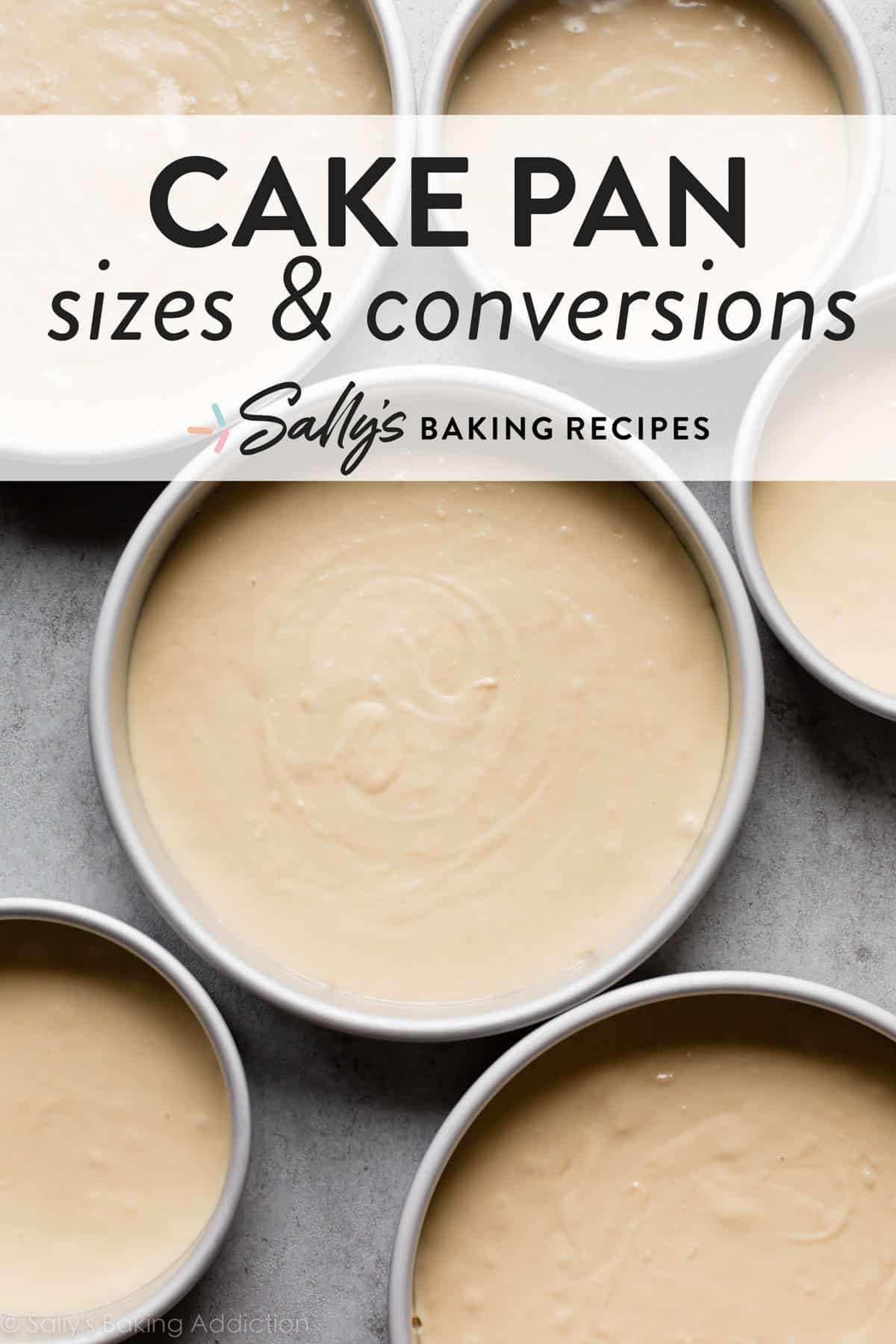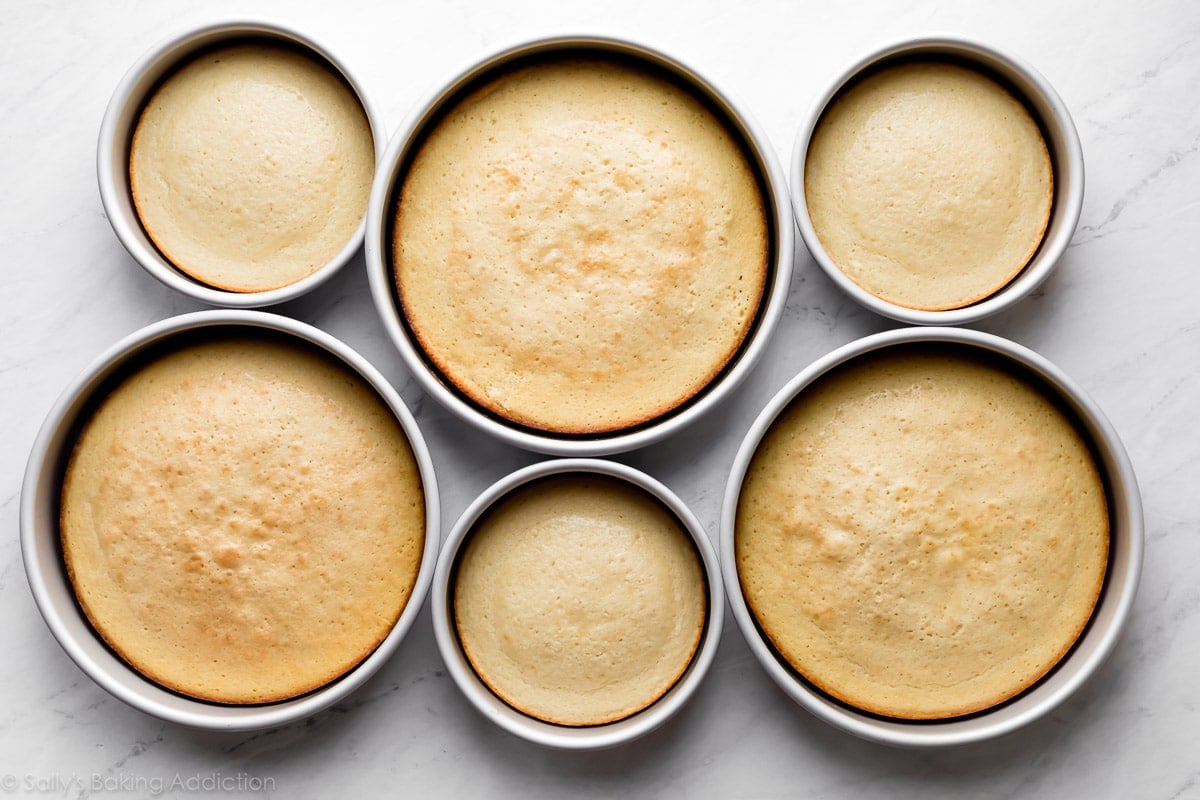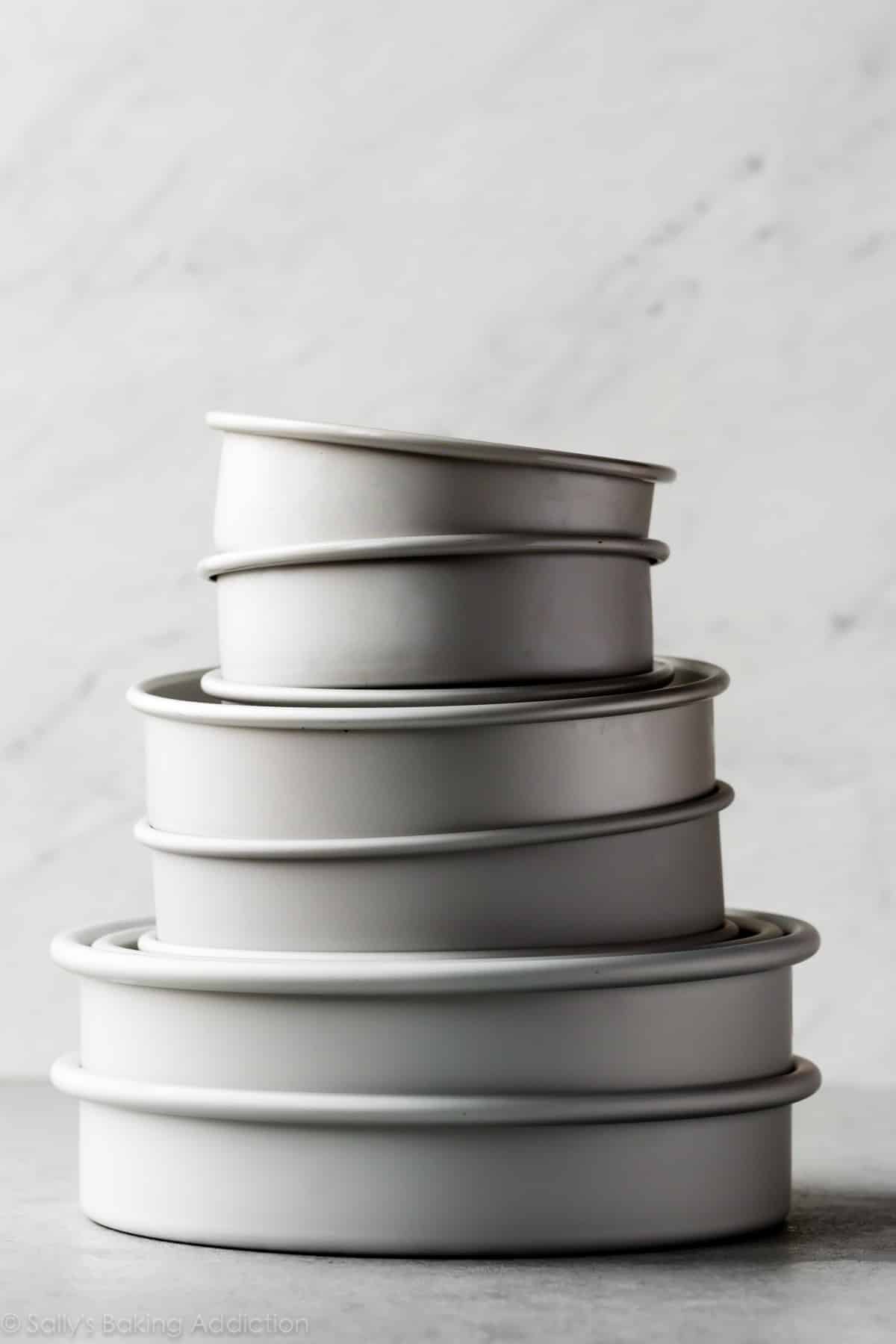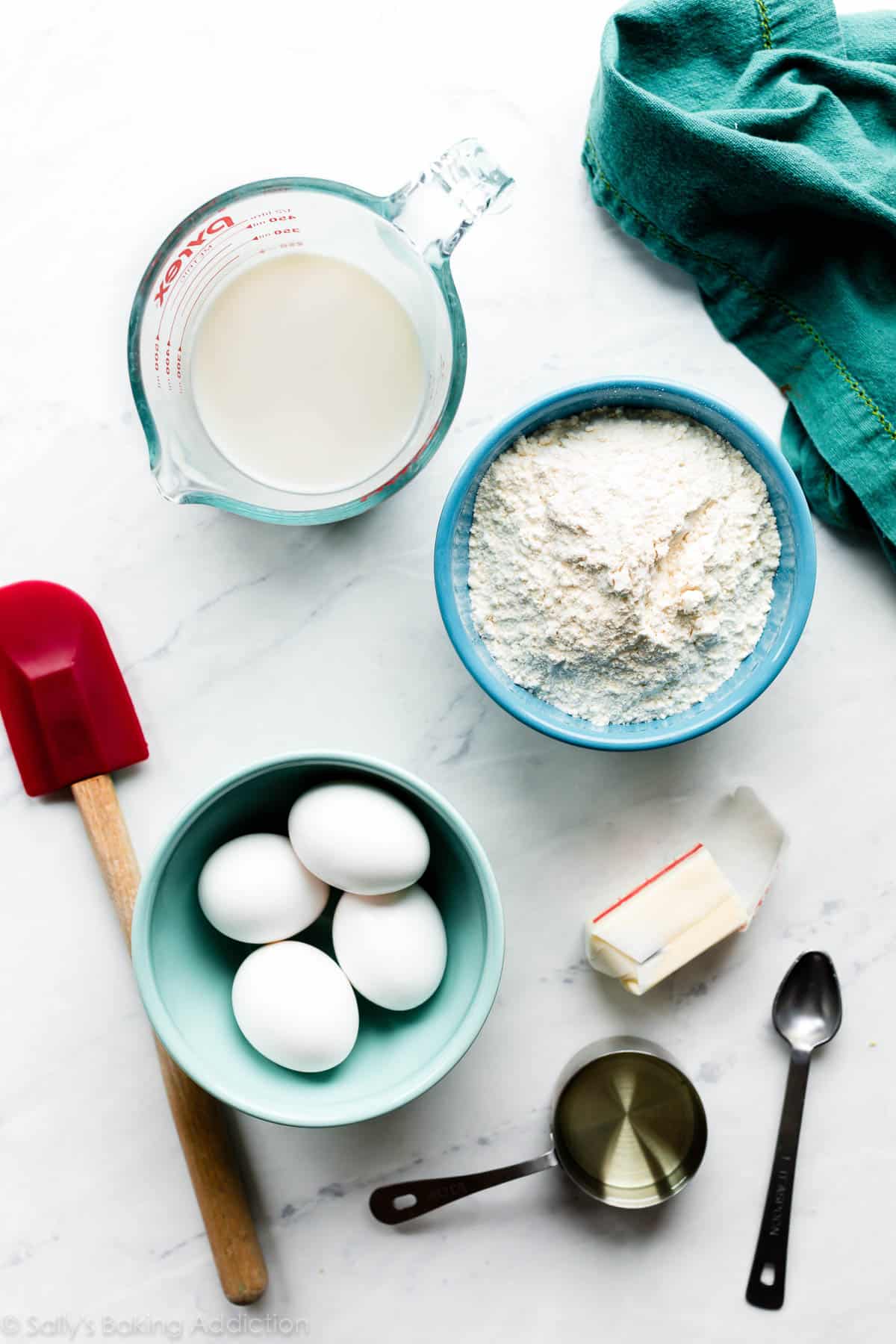Here’s an in-depth look at common cake pan sizes & conversions, as well as how to adjust recipes or make substitutions based on the pan sizes you have. Free printable included.

Unless you have a fully stocked kitchen with dozens of baking pans, chances are that you’ll run into a recipe where you don’t have the specific pan required. In fact, a cake pan substitution is the subject of most recipe questions I receive. I figured it would be easier to store all of this information in one convenient place for us all to reference.
Welcome to my Cake Pan Sizes & Conversions lesson!
This Post Includes:
- Common Baking Pan Measurements
- Cake Pans That Are Similar
- Substituting Cake Pans
- Adapting Cake Recipes to Fit Certain Pans
- Amount of Batter Some of My Cake Recipes Yield

Common Baking Pan Measurements
In this list, you’ll find common baking pan measurements and the volume of batter they hold. **The amount listed is the total amount of batter each pan holds, but you usually only fill cake pans halfway (unless otherwise noted in the recipe you are using).** Most measurements were taken at my home kitchen. Cross referenced with the always trusted Joy of Baking, as well.
Measurement Conversions
- 1 inch = 2.54cm
- 1 cup = 240ml
Round Pans:
6×2 inches (15 x 5cm) = 4 cups (960ml)
8×2 inches (20 x 5cm) = 6 cups (1.4 liters)
9×2 inches (23 x 5cm) = 8 cups (1.9 liters)
Square Pans:
8×2 inch square (20 x 5 cm) = 8 cups (1.9 liters)
9×2 inch square (23 x 5 cm) = 10 cups (2.4 liters)
10×2 inch square = (25 x 5 cm) = 12 cups (2.8 liters)
Rectangular Pans – 2 inch (5 cm) tall
11×7 inches (28 x 18 cm) = 10 cups (2.4 liters)
13×9 inches (33 x 23 cm) = 14 cups (3.3 liters)
Springform Pans:
9x 2.5 inches (23 x 6 cm) = 10 cups (2.4 liters)
10x 2.5 inches (25 x 6 cm) = 12 cups (2.8 liters)
Bundt Pan – volume varies because of various designs
10×3 inch (25 x 8 cm) = 10-12 cups (2.8 liters)
Tube Pan:
9×3 inches (23 x 8 cm) = 12 cups (2.8 liters)
Jelly Roll Pans – 1 inch (2.5 cm) tall
10×15 inches (27 x 39 cm) = 10 cups (2.4 liters)
12×17 inches (32 x 44 cm) = 12 cups (2.8 liters)
Loaf Pans – about 3 inches (8 cm) tall
8×4 inch (20 x 10 cm) = 4 cups (960 ml)
9×5 inch (23 x 13 cm) = 8 cups (1.9 liters)
How to Determine the Volume Yourself
If you want to calculate a pan’s volume yourself, it’s so easy! Simply fill your pan with 1 cup of water at a time and count until it’s full. That’s what I do!
How Much Does This Pan Hold?
Here’s a helpful list of the most common baking pans and the volume of batter they hold, as well as which pans hold the same amount of batter. ***Keep in mind that the volumes listed mean you are filling the pan all the way to the top with batter, which isn’t ideal for baked goods. Unless otherwise noted, filling pans around 2/3 full is the best practice. This leaves room for rising.
- For example, my vanilla cake recipe yields around 8 cups of batter which I divide between 3 9×2 inch round cake pans. (Each hold 8 cups of batter!) Each cake layer has a little less than 3 cups batter each.
Use the following section to determine which baking pans can be substituted for others based on their full volume.
Round Pans
- 6×2 inch round pan holds 4 cups of batter, the same as an 8×4 inch loaf pan. Fun discovery! Cupcake recipes yielding 12-16 cupcakes fit wonderfully in 3 6-inch cake pans. See my post for 6 inch cake recipes for more information.
- 8×2 inch round pan holds 6 cups of batter.
- 9×2 inch round pan holds 8 cups of batter, the same as an 8×2 inch square pan and a 9×5 inch loaf pan.
- 10×2 inch round pan holds 10-11 cups of batter, the same as a 9×2 inch square pan, 11×7 inch pan, 10×15 inch jelly roll pan, 10×3 inch Bundt pan, and a 9×2.5 inch springform pan.
Square Pans
- 8×2 inch square pan holds 8 cups of batter, the same as a 9×2 inch round pan and a 9×5 inch loaf pan.
- 9×2 inch square pan holds 10 cups of batter, the same as a 10×2 inch round pan, 11×7 inch pan, 9×2.5 inch springform pan, 10×3 inch Bundt pan, and a 10×15 inch jelly roll pan.
- 10×2 inch square pan holds 12 cups of batter, the same as a 12×17 inch jelly roll pan, 10×3 inch Bundt pan, 10×2.5 inch springform pan, and a 9-inch tube pan.
Rectangle Pans
- 11×7 inch pan holds 10 cups of batter, the same as a 10×2 inch round pan, 9×2-inch square pan, 9×2.5 inch springform pan, 10×3 inch Bundt pan, and a 10×15 inch jelly roll pan.
- 9×13 inch pan holds 14-16 cups of batter, essentially the same as 2 9×2-inch round pans.
Jelly Roll Pans
- 10×15 inch jelly roll pan holds 10 cups of batter, the same as a 10×2 inch round pan, 9-inch square pan, 11×7 pan, 9×2.5 inch springform pan, 10-inch Bundt pan.
- 12×17 inch jelly roll pan holds 12 cups of batter, the same as a 10×2 inch square pan, 10-inch Bundt pan, 10×2.5 inch springform pan, and a 9-inch tube pan.
Bundt Pans
10-inch Bundt pans are the standard size. I actually have several that are 9.5 inches and most Bundt cake recipes still fit.
- 10-inch Bundt pan holds 10-12 cups of batter, the same as a 10×2 inch round pan (10 cups), 9×2 inch square pan (10 cups), 10×2 inch square pan (12 cups), 11×7 inch pan (10 cups), 10×15 inch jelly roll pan (10 cups), 12×17 inch jelly roll pan (12 cups), 9×2.5 inch springform pan (10 cups), 10×2.5 inch springform pan (12 cups) and a 9-inch tube pan (12 cups).
Tube Pans
9×3 inch tube pans are the standard size. I have a few that are 8 inch and 10 inch and most recipes using tube pans fit nicely in all.
- 9×3 inch tube pan holds 12 cups of batter, the same as 10×2 inch square pan, 12×17 inch jelly roll pan, and a 10×2.5 inch springform pan.
Springform Pans
- 9×2.5 inch springform pan holds 10 cups of batter, the same as a 10×2 inch round pan, 9×2 inch square pan, 11×7 inch pan, a 10×15 inch jelly roll pan.
- 10×2.5 inch springform pan holds 12 cups of batter, the same as a 10×2 inch square pan, 12×17 inch jelly roll pan, and a 9×3 inch tube pan.
Loaf Pans
- 8×4 inch loaf pan holds 4 cups of batter, the same as a 6×2 inch round pan.
- 9×5 inch loaf pan holds 8 cups of batter, the same as a 9×2 inch round pan and an 8×2 inch square pan.
Substituting Cake Pans
I’m piggy-backing this one to the section above because there’s often a need to substitute different cake pans. If substituting a baking pan that holds the same amount of batter, be wary of the baking time because the dimensions of the baked good will change. Always keep your eye on the oven and begin checking for doneness earlier than the recipe states.
Remember, only fill pans about 1/2 to 2/3 full unless otherwise instructed in the recipe.

FREE PRINTABLE
Here is a free printable you can hang in your kitchen workspace: Volumes & Measurements of Common Baking Pans
Adapting Recipes to Fit Certain Cake Pans
Adapting recipes to fit the cake pans you have (or need) can often be complicated. While it’s always best to stick to the written recipe, sometimes you need to make adjustments and that’s where a little math can help.
1) Determine the volume your pan can hold. You can also determine the actual surface area of the pan in square inches. I actually used Food 52’s article by Alice Medrich on this subject to brush up on my math!
- For square and rectangle pans, multiply the length of the sides. For example, a 9×13 inch baking pan is 117 square inches. 9×13 = 117.
- For circle pans, determine the area by multiplying the radius squared by π. (π = 3.14, the radius is half of the diameter, and squaring means multiplying a number by itself.) For example, the area of a 9-inch round pan is 63. The radius is 4.5. 4.5×4.5 = 20.25. Multiply that by 3.14 = 63.5.
2) After you determine the volume your pan can hold or its square inches, you can confidently make baking pan substitutions.
- For example, if a 9×13 inch pan is 117 square inches and a 9-inch round pan is 63.5 square inches, you can be confident that the volume from one 9×13 inch pan can fit into TWO 9-inch round pans (approximately 120 square inches total).
What if volumes and square inches don’t match up perfectly? You’ll have to adjust the recipe and this requires more math.
For example, if you want to adapt a 9-inch round cake to a 10-inch round cake, you’ll need to make adjustments. A 9-inch round cake pan is 63.5 square inches/holds 8 cups of batter. A 10-inch round cake pan is 78.5 square inches/holds 10-11 cups of batter. Without any adaptions, your 10-inch cake layers will be very thin. You’ll need to increase the batter by 25%.
The get this percentage, work with the cups or square inches. Subtract the number you have (8 cups) from the number you want (10 cups). Divide that (2 cups) by what you have (8 cups), then multiply by 100. (The universal way to find a percentage.) This equals 25%.
How to Avoid the Math
What works for me most of the time (because I don’t trust myself with too much math!) is to 1.5x the recipe or even making 2 batches of batter. (For best success, taste, and texture, I always recommend making separate full batches instead of doubling. Doubling risks over-mixing or under-mixing and could overwhelm your mixer.) Then, I use leftover batter to make a few cupcakes on the side to freeze for another time.
It’s better to have extra batter rather than not enough.
What About Eggs?
If you need part of an egg for when you are adjusting a recipe, crack the egg, beat it, and whatever percentage of that mixture you need. If you need 1/3 of an egg and you have 3 Tablespoons of beaten egg, use 1 Tablespoon. For a more precise amount and if you don’t trust your measurements, you can also weigh the beaten egg on a kitchen scale to determine exactly how much you need.
- Cover, refrigerate, and add any leftovers to your scrambled eggs the next morning!

Amount of Batter Some of My Cake Recipes Yield
The following list will help if you need to adjust my recipes for different pan sizes. These are the recipes I know and all measurements are approximate.
- Checkerboard Cake: about 8 cups
- Vanilla Naked Cake: about 8 cups
- Vanilla Cake: about 8 cups
- Confetti Cake: about 8 cups
- Chocolate Cake: about 6 cups
- White Cake: about 7 cups
- Banana Cake: about 6 cups
- Strawberry Cake: about 7 cups
- Snickerdoodle Cake: about 8 cups
- Coconut Cake: about 7-8 cups
- Red Velvet Cake: about 6-7 cups
- Lemon Cake: about 7 cups
My Favorite Baking Pans
I have a list for you! Stock your kitchen with these 8 best baking pans and these 10 cake baking & decorating tools.
The next time you have a question about cake pan sizes & conversions, I hope you find your answer in this post so you can confidently make the adjustments needed.





















I have a recipe for a Bundt cake that calls to be baked at 350F for 60 min. I only have two 9 inch round pans. Can I use the round pans instead? How long would the cook time be?
I want to make a fairy castle cake for my little granddaughter, I have a 9inch square cake tin. Please can you tell me how much cake mix i will need, or a recipe with ingredients. Thankyou.
Hi Sandra, here are all of our cake recipes for browsing.
Hi sally I have been asked to make a pumpkin shaped cake out of carrot cake and thought of using a Bundt tin, I would like it as big as possible, do you have any idea how much batter I would need for each tin please.
I have never used one of these tins before , unless you have a better idea many thanks
Hi Helen, we’d recommend following out carrot cake Bundt cake recipe. You can leave out the cream cheese layer if you wish.
I want to make The Perfect White Cake in a 9 x 13 cake pan. What temp and how many minutes should I bake it for?
Hi Pat, Same oven temperature. Simply pour the batter into a greased and lightly floured 9×13-inch pan and bake for 38 minutes, or until a toothpick inserted in the center comes out clean.
Thank you for this detailed help with understanding pan conversion and batters. I want to make a sheet cake 12×17 or 18 and will be using a recipe not written for that pan. I want to be certain I understand pan volume vs batter. I think I will be looking for a cake with 6-8 cups of batter. Am I correct on this? I refer to your site exclusively, sometimes the calculating gets the best of me!
Sally, since I discovered this baking chart and am making more 6 in. cakes, I went out and bought another 6in. Fat Daddio’s pan since I really like their sturdiness, etc. but I noticed on the label on the pan, it says
Fat Daddio’s“ pan says For maximum performance, we recommend a 25 degree temperature reduction. “ I don’t remember seeing this on the one I bought earlier. Do you recommend this reduction?
Hi Ilene, we bake with Fat Daddio’s pans often and have never done a temperature reduction. Hope this helps!
i have a 4 inch springform pan and i don’t see it on here
Again, another winner for your wonderful web site. Thank you so much for posting this brilliant page
Thank you for the print out that I wish you had put more of this information onto the printout and made it a couple Pages longer there’s a lot of good stuff here!
I need help deciding if I should change the volume of batter converting a 9×13″ baking dish recipe to a 17×12″ 1/2 sheet pan. I am making small tea cakes for a tea party. Once baked, the plan is to use ~2″cookie cutters for my rounds and frost in between the layer and the tops. I don’t want the cake layers to be too tall. Can I just use the recipe for a 9×13 as is and adjust the baking time, vs using the formula to multiply the volume by 1.7 – concerned the cake will be too tall. Thanks!
Hi Leslie, that should work—the cake will be thin. Or, you can use the cake from our petit fours recipe, which is written for a 12×17-inch pan.
Thanks Lexi! I read the petit four cake recipe which called to cut the cake in half, into layers, which I read to cut crosswise, making thinner layers, yes? Do you think those layers would equal about the same height as baking Sally’s vanilla sheet cake w/whipped buttercream frosting recipe which is what I was thinking to use. Thanks for all your help!
Hi, I would like to bake some of the cake recipes, but as mini loaves, rather than a full sized cake (because sometimes we all need that portion control :D). Is there anything I need to be aware of when doing so? I usually use the normal cake recipes and just adjust the cooking time for mini loaf size. Doesn’t always work though.
Thank you!
PS: I love this blog, it has been a life saver.
Hi Jackie, we’d recommend filling your mini loaf pans half way, then as you mention, keeping a close eye on them for bake time since it will be shorter and vary by recipe. Thank you for making and trusting our recipes!
To bake a 1 kilo ribbon cake what size rectangle cake pan should I use for 1 kilo cake batter
Great recipe! How many minutes should I bake a 9 x 13 inch cake with 2/3 the amount of batter?
I’m trying to perfect a Victoria Sandwich cake. I’ve tired 3 x using different recipes but they have all come out greasy and pound cake like in texture. I am at 9000 ft and have not altered the recipes for high altitude baking. What am I doing wrong?
Hi Dhana, we wish we could help, but we have no experience baking at high altitude. Some readers have found this chart helpful: https://www.kingarthurflour.com/learn/high-altitude-baking.html
When is it best to use metal pans versus glass pans? Do the metal pans bake better than glass?
Hi Trina, we typically prefer to use metal pans when baking, especially when it comes to cakes and loaves of bread. Metal pans conduct heat more quickly than glass and help the batter to bake evenly. If you do use a glass pan for bread, note that it will take a few minutes longer. We do, however, prefer baking with glass pie dishes, since the clear bottom allows us to see how the crust is progressing. Hope this helps!
Oh thank you, thank you, thank you! This information is a life changer for me. I bake many cakes for family and friends and am always in need of special sizes for sculpting and shaping cakes. You have an awesome website with great information and recipes I can always rely on.
So glad you found this helpful, Karen!
I have hunted for years to get measurements for baking pans, bundt pans, and rectangular pans. Now that I have it at my finger tops, I can pass it along to my friends, grandkids, and one day to my two great- granddaughters, currently ages 7 and 3. Thank you!